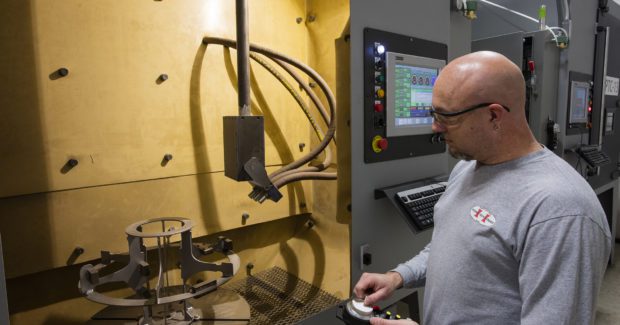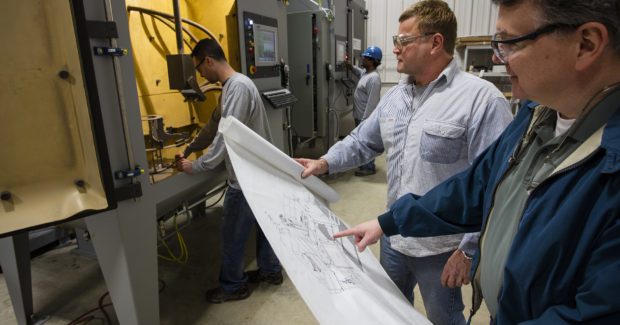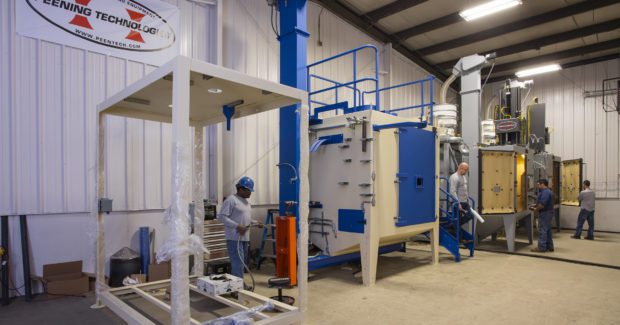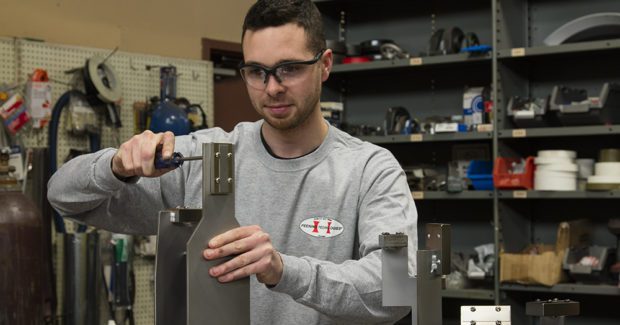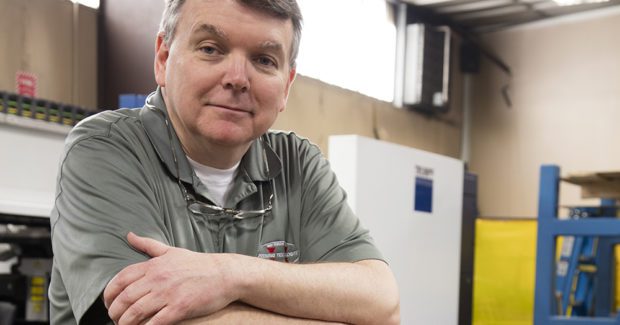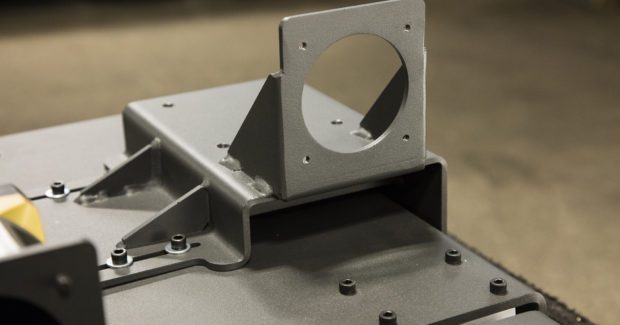Taking a Shot at Laser Cutting
Take a closer look at how laser cutting helped this small business develop a big presence in the shot peening industry.
Posted: October 10, 2016
“Shot peening is a finishing process used to make critical components stronger, as well as to extend the life of less critical parts. It is relatively inexpensive compared to the cost of replacement or repair. Shot peening is also used to facilitate coating adhesion, such as nickel plating, or to produce a controlled and uniform look for architectural railings,”
Peening Technologies (East Hartford, CT) builds state-of-the-art, affordable, computer-controlled shot peening equipment and also offers shot peening, abrasive blasting and surface enhancement job shop services to the aerospace, automotive, power generation, medical, oil and gas exploration industries. This family-owned company has reason to celebrate: Not only are they preparing for their 50th anniversary, they also just received their first patent. In the following interview, company president Thomas Beach and his brother, vice president Walter Beach, share more about this small business that has a big presence in the shot peening industry.
Can you provide a short history of your company?
Thomas: Our father founded the shot peening job shop segment of our company in 1966. Eventually, customers expressed an interest in buying the equipment we had designed so rather than lose business, we began to offer machines as well. While the job shop is still the larger segment of our business, both aspects have grown steadily over the years. We have grown to workforce of approximately 80 employees, including our facility near Atlanta, GA. We established an operation there in 2003 at the request of a local customer who required job shop services in the South.
How is shot peening used across various industries?
Thomas: Shot peening is a finishing process used to make critical components stronger, as well as to extend the life of less critical parts. Since it is relatively inexpensive compared to the cost of replacement or repair, it is an attractive solution for many industries. We commonly see aerospace, automotive, or power generation applications but also medical implants – for the patient, a longer-lasting implant is a real advantage. Other manufacturers are drawn to shot peening for reasons that have nothing to do with fatigue life. For example, shot peening is used to facilitate coating adhesion, such as nickel plating, or to produce a controlled and uniform look for architectural railings.
Walter: As technology advances, we see growing use in the automotive and aerospace sectors especially. In the past, it was simply understood that shot peening had a beneficial effect on materials. With computers we are able to quantify this impact much more precisely. This enables engineers to work with thinner or different materials. This is a major attraction for automotive manufactures, for example, on a quest for lightweight designs. In addition, the parts are even less susceptible to fatigue failure.
What makes Peening Technologies unique?
Thomas: We make sophisticated automated equipment for shot peening and also supply shot peening as a job shop service. Our competitors typically do not offer both. Understanding both the machine and the process gives us a unique understanding of our customers’ needs and has enabled us to become a leader in shot peening technology and automation. When people think of shot peening, we want them to think of us. Walter: We also understand the numerous approvals and quality requirements that go along with shot peening. In addition to our FAA and EASA approvals, we are proud to be the first shot peening facility to earn Nadcap accreditation. From the specifications for the media we use, to testing processes and quality control, there is a lot to know and this is often a barrier to entry for others.
How has technology impacted growth of your business?
Thomas: Quality requirements in the industry became much more stringent just as shot peening technology began to evolve. For a small company, I think we have done well to take advantage of technologies as they become available. One of the most influential was the early adoption of 3D CAD modeling software. At the time it was an expensive proposition but it really paid dividends. Walter: We initially invested in 3D software in 2000 as a means to transition the customer’s 3D models into 2D process sheets. Although we took to the software pretty quickly, it took time for the new programming capabilities to change our process. Eventually we transformed what was once a crude process into something much more specific and refined.
Can you tell us more about the process of shot peening?
Walter: Shot peening is a surface enhancement process that works through the controlled application of media, usually steel, ceramics or glass. As the media strikes the metal part it creates a compressed layer in the material called a compressive stress. The compressive stress layer slows crack initiation or propagation through the part. While manufacturers typically only require this in key areas of the component, often the entire part or assembly is exposed to the media simply because it is faster and less costly than trying to protect it. At Peening Technologies, we process parts that range from those small enough to fit in your hand to parts that weigh thousands of pounds. Regardless of the size, a fixture must be developed to hold the part during processing. And that’s where our patent comes in.
Your patent is titled “Apparatus and Method for Quantifying Metal Surface Treatment.” Can you describe it?
Thomas: In shot peening, every fixture is attached to industry-mandated Almen holders. What most people don’t realize is that designing these fixtures is very labor intensive. On rare occasion, we might acquire a scrap part in advance, but typically we had to wait for the customer to send the part and then machine a solution. Simulations were either extremely crude or so over the top that no one could justify paying for them. We developed a way to use 3D software to generate a highly accurate simulation of the part with the holders. This method became our patent.
Why was this new method so important to your business?
Walter: The method enabled us to fabricate our tooling ahead of time and it is accurate to within a few thousands of an inch. Although there is certain testing required once the part is in hand, we are able to get to that point much faster while significantly reducing our costs. Thomas: We developed the process out of necessity, really. The industry has an increasing need for shot peening and we take on increasingly complex work. We were struggling to find a way to shorten our development time. And we found one.
What led you to patent this process?
Thomas: It was actually a customer who encouraged us to seek out a patent. Shortly after we installed a TruLaser 1030 laser cutting system from TRUMPF Inc. (Farmington, CT), he was visiting our facility to witness and approve our process. He told us nobody else was doing anything like it and we should probably patent it. We thought he was most likely right and started the process. It took just over three years and was officially granted on June 23, 2015.
Why was the addition of the TruLaser 1030 so important to your process?
Thomas: While we don’t run the laser cutting system every day, it has become a crucial and integral part of our process. When we purchased the system in 2012, it significantly changed the way we looked at fixtures. In the past, we would job shop the fabrication out. We have good vendors, but at such a low quantity our jobs could end up on the backburner. However, the nature of our business is speed, so we felt compelled to bring this step in-house. We originally looked to invest in a plasma cutting machine, but after visiting TRUMPF, we realized all the additional benefits that a laser cutting system could afford. We could cut faster and more accurately, as well as design parts in new ways and with difficult contours. The laser machine enabled us to be much more efficient and creative.
Walter: With the addition of the TruLaser, fixtures were no longer an expensive proposition. We have thousands of parts and fixtures in our database. Unavoidably, they are subject to wear due to the nature of the process. The new fixtures are so fast and easy to reproduce that we no longer need to keep fixtures in stock. This saves space and makes it easier to get exactly what you need, when you need it. Thomas: The TruLaser 1030 also enabled us to manufacture parts for our shot peening equipment in-house. It takes approximately three months to design the enclosures, motion units, and media delivery in a way that will suit the customer’s manufacturing needs and the environment where the machine will be placed. While we still machine parts, when we can cut parts for the robotic units and the enclosure with the TruLaser 1030, the entire assembly becomes more economical to produce and we are able to pass these savings on to the customer.
Everything seems to be going so well at Peening Technologies. What is the most challenging part of your business?
Thomas: Since shot peening is often applied to high dollar parts, even a small job for us is often a big concern for the customer. We frequently provide additional support long after the part or equipment has been delivered. This takes time and resources, but we understand how important it is to make sure everything is precisely right in processing. With such a large customer base, this is both a blessing and a curse, but also a responsibility we take on willingly.
INNOVATIONS IN SHOT PEENING
Hydro Honing Laboratories, Inc. (East Hartford, CT), the parent company of Peening Technologies, has patented a process for producing Almen strip fixtures utilizing 3D modeling called “Apparatus and Method for Quantifying Metal Surface Treatment” (Patent Number US 9,063,049 B2). The process was developed by Thomas Beach and Walter Beach of Peening Technologies and is already in use at their two shot peening job shops in Connecticut and Georgia that service the aerospace, automotive, and power generation industries. Peening Technologies specializes in work for the demanding aerospace industry and was the first shot peening company to receive Nadcap accreditation. (They are Nadcap accredited in Surface Enhancement and Nondestructive Testing – Liquid Penetrant, Magnetic Particle.) A third company, Peening Technologies Equipment, designs, builds and sells custom shot peening equipment to a variety of markets.
“We were looking for ways to make Almen fixtures quickly, efficiently, and at a lower price point,” said Walter Beach. “Typical Almen fixtures – at least, accurate ones – often require a lot of expensive machining along with long lead times. Scrap parts make nice Almen fixtures, but are not often available and they can be expensive to convert.” Most specifications require Almen strips to be placed in locations representing the surfaces requiring intensity verification. However, these specifications offer very little guidance on how to obtain accurate verification data. As a result, Almen fixtures can often be no more than rough representations of the part being peened. “Our method allows us to make our fixtures very accurate without pricing ourselves out of business,” noted Walter.
The first step in this patented process is to create a computer-generated 3D part model that identifies the location(s) where intensity should be verified. With this information, Almen strip holding blocks are positioned on the model in the 3D computer program and a support structure is designed. This structure is then typically laser cut into a collection of parts. These parts, along with the Almen strip holders, are welded together to create a customized unit. Peening Technologies developed this process soon after their investment in a TruLaser 1030 laser cutter several years ago. OEM customers began saying they had never seen fixtures like this and several said, “you should patent that!” Encouraged by their customers’ response, Thomas and Walter began writing their first patent.
The 3D modeling method has become Peening Technologies’ primary tool for fixture fabrication. With the company’s in-house laser cutter, they can easily save the test fixture’s digital files for easy storage and retrieval. “This method greatly accelerates the development of a new shot peening process. What used to take days or weeks now can be done in only a few hours,” added Walter. “In the world of aerospace manufacturing, time is in short supply, so being able to react quickly and deliver parts quickly is key to our success.”
This interview was conducted by Susan Grohs of TRUMPF Inc., 111 Hyde Road, Farmington Industrial Park, Farmington, CT 06032, 860-255-6039, www.us.trumpf.com.
Peening Technologies, 8 Eastern Park Road, East Hartford CT 06108, 860-289-4328, Fax: 860-289-2134, www.peentech.com.


